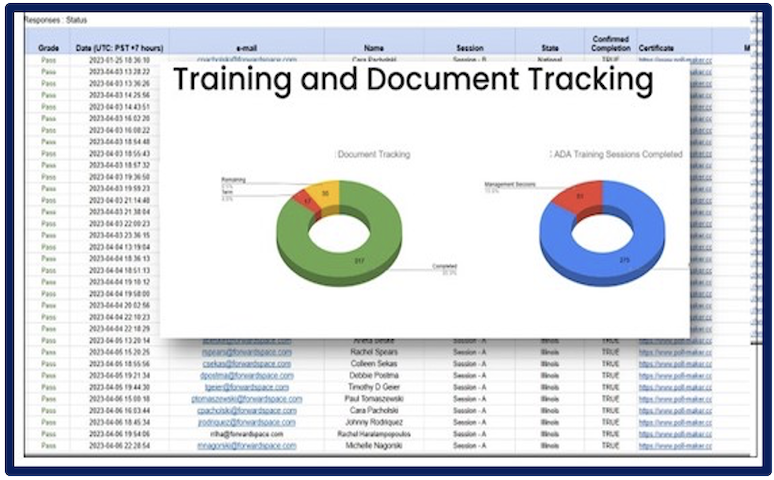
California Workplace Violence Prevention Training
Compliance Alert!
California employers with 10 or more employees need Workplace Violence Prevention Training and a Plan by July 1, 2024
Compliance with SB 553 Cal-OSHA’s New Training Mandate
California employers must provide a workplace free of recognized hazards — including Workplace Violence. SB553 training includes:
De-escalating conflicts, risk factors, warning signs, active shooter, and more.
Online training, plan templates, checklists, and forms for easy compliance.
SCORM compliant for easy LMS integration
Less than $10/person - Why pay more?
Includes online training and a written plan template to comply with California SB553.
Click on the graphic above to try a FREE full-length training session. No hassle and no credit card required.
If you need customized training, we can work with you to make the training fit your needs.
Cal-OSHA SB553 Workplace Violence Prevention Legal Requirements
Cal-OSHA mandates annual Workplace Violence Prevention training from Senate Bill 553. The deadline is July 1, 2024 for a complete program: training, compliance reporting, and a published plan. OSHA’s general duty clause requires that employers provide a workplace free of any recognized hazard — which includes Workplace Violence. According to the general duty clause or Section 5(a)(1) of the Occupational Safety and Health Act of 1970, employers are required to provide their employees with a place of employment that is “free from recognized hazards that are causing or are likely to cause death or serious physical harm." Employers who have had acts of workplace violence, or become aware of threats, intimidation, or other risk factors should be on notice that steps must be taken including safety protocols and training.
This training is specifically for California employers which complies the mandates of new law when presented in conjunction with the specifics of your plan and presentation by a knowledgeable presenter. We provide an overview of risk factors, warning signs, how to de-escalate and diffuse a potentially volatile situation, and options for responding in case of a violent incident. Employers cover their plan, recordkeeping, responsibilities, and specific evacuation procedures. This way, detailed information can be provided to staff online, and a discussion of the specifics can happen off-line.
This course exceeds the SB553 mandates and provides a solid way to give employees skills and confidence in their abilities to respond to a volatile situation.
Your package includes: online training, written plan template, training checklist, forms, recordkeeping schedule and everything you need for compliance with SB553.
Get your California Workplace Violence Prevention training done in 4 easy steps before the July 1 deadline
Step 3: Completion Certificates
Certificates awarded to trainees.
Step 4: Tracking/Compliance
Compliance tracking made simple!

Workplace Violence Prevention Training Value YOU Gain:
100% Satisfaction, money-back guarantee!
Includes written plan template, online training, training checklist, forms, and more!
High Impact - Clients love the training! 99% of participants confirmed enhanced understanding and rated us 9.2 (of 10 NPS)!
High Value - less than $9.99/ employee
Exceeds State and Federal Law requirements
Two versions: National and California
Flexible: available 24/7 Mobile Friendly
Full Year Access to training and resource library

2024 Workplace Violence Prevention Training Sessions for Employees
Please note: We allow two demos per organization.
To set up an account, click here.
Sample Workplace Violence Prevention Plan from Cal-OSHA in WORD format
Note: This training provides the basics of workplace violence prevention, risk factors, warning signs, de-escalating conflicts, and more important information. Employers must also have a written plan and train staff about the plan, emergency response protocols, and provide an opportunity for interactive questions and answers with a person knowledgeable about the plan.
Training Content for SB553, the Cal-OSHA Workplace Violence Prevention Program
The training focuses on workplace violence prevention and requires employers to provide training to employees. The training content typically covers the following key aspects:
Recognition of Potential Risks: Employees are trained to recognize signs and behaviors that may indicate a risk of workplace violence, including verbal threats, physical aggression, and other concerning behaviors.
Preventive Measures: Training emphasizes proactive measures to prevent workplace violence, such as effective communication techniques, conflict resolution strategies, and de-escalation tactics.
Policies and Procedures: Employees are educated about the organization's policies and procedures related to workplace violence prevention, including reporting mechanisms, emergency protocols, and available resources for assistance.
Response Protocols: Training equips employees with knowledge of how to respond effectively in the event of a workplace violence incident, including steps to ensure personal safety, how to seek help, and how to assist others if needed.
Legal Rights and Responsibilities: Employees learn about their legal rights and responsibilities concerning workplace violence prevention, including anti-retaliation protections for reporting incidents and cooperating with investigations.
Role-Specific Training or Case Studies: Depending on job roles and responsibilities, employees may receive specialized training tailored to their specific workplace environment and potential exposure to violence risks.
Employer’s Written Plan: Training also to include employee communication protocols, recordkeeping, evacuation routes, and other details on the WVPP. (To be conducted offline by a person knowledgeable about the plan).
Overall, SB553 workplace violence prevention training aims to empower employees with the knowledge and skills needed to identify, prevent, and respond to incidents of workplace violence effectively. By providing comprehensive training, employers can foster a safer work environment and promote employee well-being.
The California Division of Occupational Safety and Health (Cal/OSHA) mandates workplace violence prevention programs to ensure the safety and well-being of employees. Key requirements of the Cal/OSHA workplace violence prevention program include:
Risk Assessment: Employers must conduct a thorough assessment to identify potential hazards and risks related to workplace violence.
Written Program: Employers are required to develop a written workplace violence prevention program that outlines policies, procedures, and strategies to prevent and address incidents of violence.
Training: Employees must receive training on recognizing and preventing workplace violence, as well as on procedures to follow in case of an incident.
Incident Investigation: Employers must establish procedures for promptly investigating and documenting workplace violence incidents.
Record-Keeping: Records of workplace violence incidents, investigations, and corrective actions must be maintained.
Annual Review: The workplace violence prevention program should be reviewed annually and updated as necessary to address changing circumstances or emerging risks.
Consultation with Employees: Employers must involve employees in the development, implementation, and review of the workplace violence prevention program.
Communication: Employers should ensure effective communication of the workplace violence prevention policies and procedures to all employees.
Medical Services and First Aid: Provision of appropriate medical services and first aid to employees affected by workplace violence incidents.
CALIFORNIA WORKPLACE VIOLENCE PREVENTION
Steps for Employees to Take to Prevent and Respond to Tense and Potentially Volatile Situations
ALARMING STATISTICS
In the US, there were 761 workplace deaths caused by violence in 2021, and 2.6 million non-fatal workplace injuries.
85% of workplace violence deaths are due to robbery.
Workplace assaults resulted in 20,050 injuries and 392 fatalities in 2020 alone.
Workplace violence causes American businesses to lose, on average, $250 to $330 billion every year.
WHAT IS WORKPLACE VIOLENCE?
Workplace violence includes, but is not limited to, the following:
The threat or use of physical force against an employee that results in, or has a high likelihood of resulting in, injury, psychological trauma, or stress, regardless of whether the employee sustains an injury.
An incident involving a threat or use of a firearm or other dangerous weapon, including the use of common objects as weapons, regardless of whether the employee sustains an injury
Any act of violence or threat of violence that occurs in a place of employment
TYPES OF WORKPLACE VIOLENCE
Violence committed by a person who has no legitimate business at the worksite, and includes violent acts by anyone who enters the workplace or approaches employees with the intent to commit a crime.
Violence directed at employees by customers, clients, patients, students, inmates, visitors, or other third parties.
Violence against an employee by a present or former employee, supervisor, or manager.
Workplace violence committed in the workplace by a person who does not work there, but has or is known to have had a personal relationship with an employee.
Workplace violence does not include lawful acts of self-defense or defense of others.
Work practice controls - Procedures and rules which are used to effectively reduce workplace violence hazards.
WHY ARE WE DOING THIS TRAINING?
Build Skills and Confidence
Safety and Health
Legal Compliance
AGENDA
De-Escalating Conflict And Preventing Volatile Situations
WARNING SIGNS OF ESCALATING BEHAVIOR
TRIGGERS FOR WORKPLACE VIOLENCE
Job layoffs or threats of job elimination
Pressure for increased productivity
Psychological instability
Lack of individual responsibility
Unstable economy
Non job-related personal problems
Unresolved workplace conflict
Domestic disputes/spousal abuse
Some examples of what triggers a violent episode
BEHAVIORAL WARNING SIGNS
Direct or veiled verbal threats.
Intimidating behavior towards others.
Fascination with weapons or violent acts.
Inability to accept constructive criticism of job performance.
Exhibiting moral righteousness and believing the employer is not following law, rules, and procedures.
Displaying unwarranted anger; displaying violence towards inanimate objects.
Demonstrating paranoid behavior.
Unreasonably holding a grudge, usually against a supervisor.
Extreme mood swings.
Extreme family, financial, or other personal problems.
Stealing or sabotaging equipment.
Displaying obsession about job and not usually having outside interests.
Drug or alcohol use, especially increased use.
RISK FACTORS
Working alone
Working late at night or early morning
Working with money
Dealing with the public
Delivering passengers or goods
Working in high crime areas
Working with people who have a history of violence
Working in community settings
Having a mobile workplace (police car or taxi)
DE-ESCALATING A TENSE SITUATION
ESCALATING THREAT LEVELS
THE ESCALATION CYCLE
Pattern Occurring Before, During, and After an Episode
STEPS FOR DETERMINING ACTIONS
Determine the Best Response
Have the courage and confidence to do something. NEVER put yourself in harm’s way but DO SOMETHING! Help can be direct or indirect. Directly address the situation. Step in and say or do something to stop the situation.
WHO SHOULD TAKE ACTION?
Be courageous and step up.
If you see something, say something. This requires personal assertiveness. Your silence is license to continue the behavior.
Defer to a Third Party
WHO SHOULD TAKE ACTION?
Team Up!
Use teamwork to distract and delegate.
Get another person on board to interrupt the situation long enough for you to find help
Be courageous and step up.
If you see something, say something. This requires personal assertiveness. Your silence is license to continue the behavior.
Defer to a Third Party
WHO SHOULD TAKE ACTION?
Team Up!
BE ALERT, DETERMINE BEST RESPONSE
Body Language:
Be calm, polite, respectful
Speak softly but firmly
Maintain eye contact without staring
Avoid threatening gestures, clenched fists, power stances
When emotion is high, logic is low
Verbal
Say please
Use their name – get their attention.
Use words like “let’s” “we” and “together”
Provide options – get the person to make a decision so they feel more in control.
When emotion is high, logic is low
“Can we please not do that…”
Less emphatic: “Let’s keep it professional…”
Direct and emphatic: “Stop acting that way” “leave that alone” or “cut it out”
What you say depends on the situation.
WHAT TO DO
If you suspect something, say something. The sooner the better. Waiting until the situation has escalated will not help.
Contact your manager, the Police, or another person of authority who can assist.
DON’T MAKE THESE MISTAKES
Don’t put yourself in danger.
Don’t leave a co-worker alone in a questionable situation.
Don’t intervene on your own if the situation is questionable -- team up with another person to address the situation.
Don’t ignore, avoid, sweep it under the rug, or make a joke about the situation.
Don’t remain silent or stand by if there is something you can safely do to intervene.
Don’t assume someone else will intervene.
ESSENTIALS FOR DIFFUSING A TENSE SITUATION
IF A VIOLENT EPISODE OCCURS
ACTIVE SHOOTER – HOW TO RESPOND FROM US DEPT OF HOMELAND SECURITY
1. Evacuate
If there is an accessible escape path, attempt to evacuate the premises. Be sure to:
• Have an escape route and plan in mind
• Evacuate regardless of whether others agree to follow
• Leave your belongings behind
• Help others escape, if possible
• Prevent individuals from entering an area where the active shooter may be
• Keep your hands visible
• Follow the instructions of any police officers
• Do not attempt to move wounded people
• Call 911 when you are safe
2. Hide Out
If evacuation is not possible, find a place to hide where the active shooter is less likely to find you. Your hiding place should:
Be out of the active shooter’s view
Provide protection if shots are fired in your direction (i.e., an office with a closed and locked door)
Not trap you or restrict your options for movement
3. ACT UP
As a last resort, and only when your life is in imminent danger, attempt to disrupt and/or incapacitate the active shooter by:
Acting as aggressively as possible against them
Throwing items and improvising weapons
Yelling
Committing to your actions
YOUR ORGANIZATION’S PLAN
Employee Communication, Emergency Response Protocols, and Reporting
NON-RETALIATION
Your organization has a policy against retaliation against an employee for bringing an issue to the attention of management
Concern
Problem
Suspicion
Use your complaint handling procedure to advise your manager about any issues
Your Organization’s Policy Against Retaliation
WORKPLACE VIOLENCE PREVENTION PLAN
Names of person
The names of persons responsible for its implementation.
|Effective procedures for employee involvement in developing and implementing the plan.
Methods to coordinate implementation of the plan with other employers, when applicable.
Procedures for employers to handle and respond to reports of workplace violence, while ensuring no retaliation against the reporting employee.
Procedures to ensure compliance from employees, including supervisors.
Your Organization’s Plan Should include:
PROCEDURES TO COMMUNICATE WITH EMPLOYEES
Emergency Response Protocols
Identify and evaluate workplace violence hazards that include inspections with the following frequency:
When the plan is first set up.
Periodically scheduled.
After violent incidents.
Whenever a new hazard becomes known.
Procedures
Procedures to timely correct workplace violence hazards identified and evaluated.
Procedures for post-incident response and investigation.
Procedures that allow for plan review
Annually.
When a deficiency is observed or becomes apparent.
After a workplace violence incident.
Any other procedure necessary for employee health and safety
Training Provisions
RECORDKEEPING REQUIREMENTS
Incident date, time, location.
Workplace violence “Type” (1, 2, 3, and/or 4).
Detailed description of the incident.
Classification of who committed the violence.
The circumstances at the time of the incident.
Where the incident occurred.
Specific incident characteristics, such as physical attacks, weapon involvement, threats, sexual assault, animal incidents, or other events.
What the consequences of the incident were, including any involvement law enforcement.
What steps were taken to protect employees from further threat or hazards.
Who completed the log, including their name, job title, and the date completed.
Note: Employers must exclude personal identifying information that would identify any person involved in a violent incident.
Violence Incidence Log - Where it is located and how to fill it out. Record retention requirements
YOUR EMPLOYER’S PLAN
Emergency Response
Workplace Violence
How to Report an Issue
Discuss the Provisions of these Policies
SUMMARY
Constant Vigilance! Be aware of your surroundings and notice the warning signs
Report any suspicions to prevent a situation from occurring
Respond according to the situation to diffuse stress and emotion
Use your resources:
Supervisor and Managers
Police
Authoritative Person

We will be honored to service your HR Training needs. Please let us know how we can help you and/or if you have any questions.
Resources for Employers
Sample Workplace Violence Prevention Plan from Cal-OSHA in WORD format









